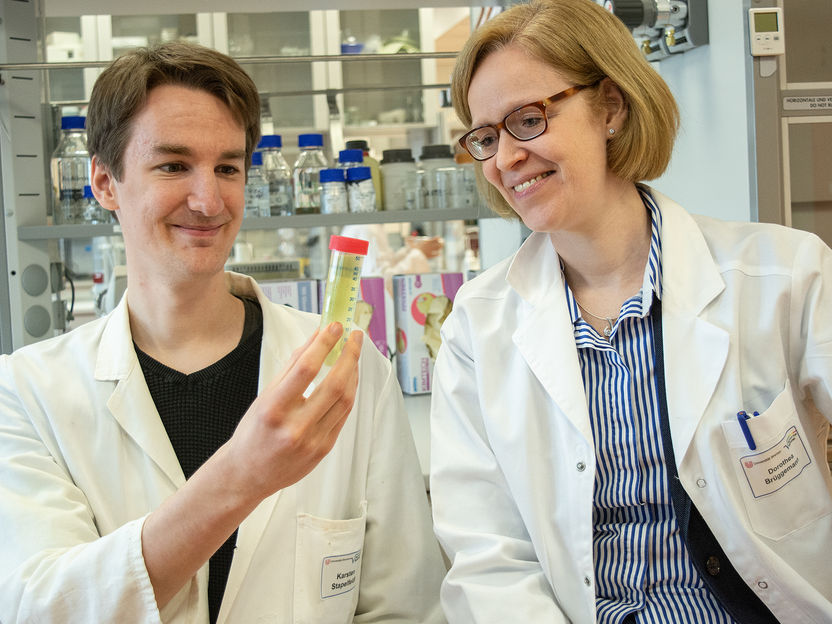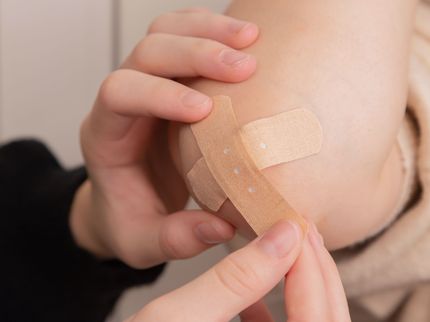“Biological Bandage” Could Help Heal Wounds
Advertisement
Scientists at the University of Bremen have now developed a three-dimensional protein structure in the laboratory that could help to heal wounds in the future. It is conceivable that one day this network could be produced as a kind of “biological bandage” from the blood of the person who will use it. The development is now patent pending.

Is the "biological bandage" coming soon? A team of researchers at the University of Bremen led by Professor Dorothea Brüggemann and PhD student Karsten Stapelfeldt has now created a fibrinogen network in the laboratory that promises progress in wound healing.
© Kai Uwe Bohn / Universität Bremen
Humans are vulnerable: one cut and they bleed. Fortunately, nature has its own solutions at the ready to treat minor injuries at the least: in order to close the wound quickly and enable the healing process, the protein fibrinogen, which is contained in blood plasma, is converted into fibrin and forms nanofibers. The scab develops. The resulting tissue of microscopically fine fibers ensures that the wound closes and also supports healing. A team of biophysicists from the University of Bremen led by Professor Dorothea Brüggemann and doctoral student Karsten Stapelfeldt has now succeeded in creating such a biological fibrinogen network in the laboratory. The discovery promises new possibilities in wound care in the future.
Material from Our Own Blood
“Normally, when you have a wound, you can help yourself with bandages and compresses, which also represent a tissue, albeit a synthetic one,” explains Dorothea Brüggemann. “Our process enables biological wound dressings that could even be formed from a person’s own blood.” Put simply, every human being could one day have their own “biological bandage,” which is ideally accepted by the body and has clear advantages in wound care, but also as a coating for implants.
A random discovery under the scanning electron microscope helped the Bremen research team. Doctoral student Karsten Stapelfeldt investigated the self-organization process that turns dissolved proteins into ultrafine fibers that then combine to form tissue. “Fibers appeared in places we didn’t expect them to,” he says. The research group was interested and focused their research on the formation of fibrinogen networks.
Natural Wound Dressing: Will We Soon Be Able to Get Scabs in a Tube?
“In the end, we succeeded in producing a layer several micrometers thick of the natural fibrinogen structure – something that you can actually take charge of. This can become the basis for a ‘natural’ wound dressing – in other words, scabs in a tube,” explains Karsten Stapelfeldt. The “individual bandage,” which is made of our own organic material, was made possible by the Bremen discovery: “There’s never been anything like this before. Maybe one day people will have blood taken as infants in order to have such fibrinogen bandages ‘in stock’ for them,” wonders Dorothea Brüggemann. “We see great potential for the future in this discovery.” This is why the team has filed a European patent application with the help of Bremen patent agency InnoWi GmbH.
The researchers in Dorothea Brüggemann’s working group still have a lot of work to do before the development comes close to being used in real life: “We will now test how cell cultures react to our fibrinogen networks, how they grow under certain conditions, and what the mechanical stability of the structures is like.”
Original publication
Karsten Stapelfeldt et al.; "Fabrication of 3D-nanofibrous fibrinogen scaffolds using salt-induced self assembly"; Biofabrication; 2019, Volume 11, Number 2




















































